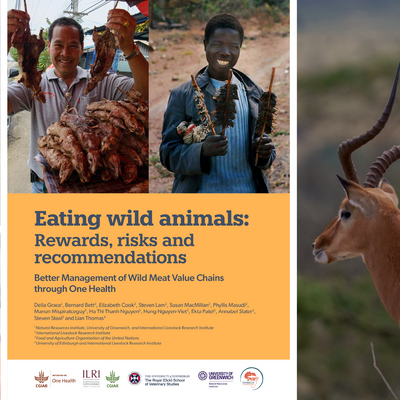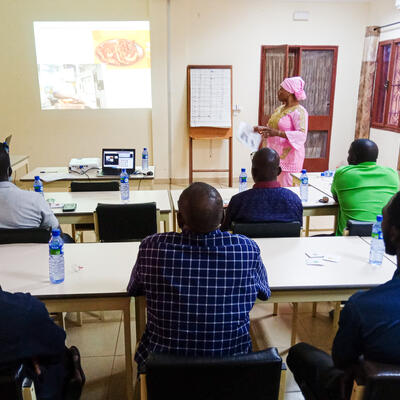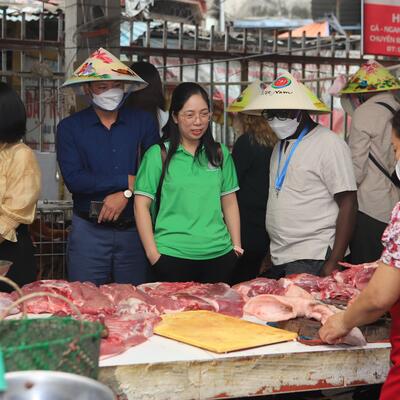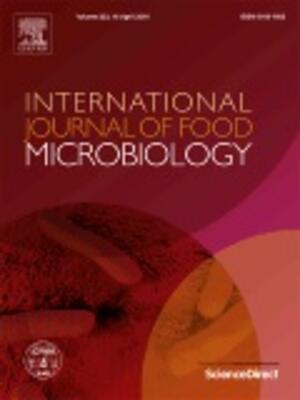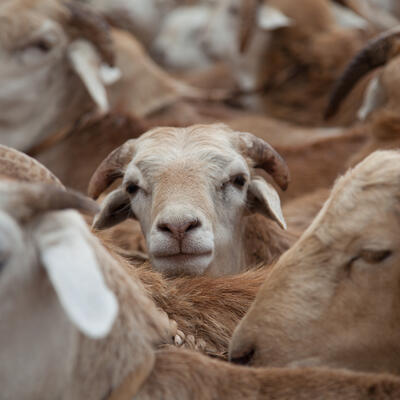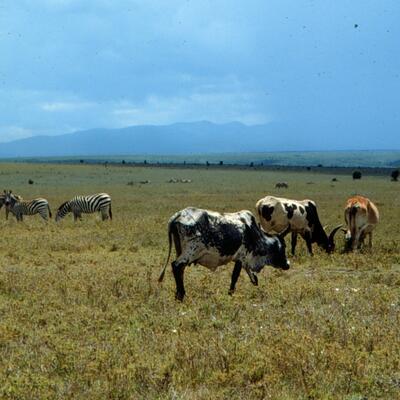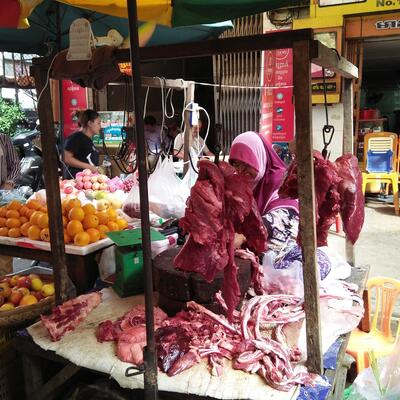
Shirley Tarawali on convergence in consumption of milk, meat, eggs at the Global Forum for Food and Agriculture

(Left) moderator Nathalie Randin and keynote speaker Shirley Tarawali at an expert panel session of the Global Forum for Food and Agriculture (photo credit: ILRI/Susan MacMillan).
On 17 Jan 2018, one of ten expert panel discussions at the Global Forum for Food and Agriculture (GFFA) was held on Food of animal origin 2030: Solutions to consumption-driven challenges. This two-hour session was organized jointly by Switzerland’s Federal Office for Agriculture and the Global Agenda for Sustainable Livestock (GASL).
This session, moderated by independent journalist Nathalie Randin, consisted of a keynote presentation delivered by Shirley Tarawali, assistant director general of the International Livestock Research Institute (ILRI), and developed by her and two of her ILRI colleagues, agricultural economist Dolapo Enahoro and spatial analyst Catherine Pfeifer.
Tarawali’s keynote was followed by two panel sessions. The first panel consisted of government representatives, including Adrian Aebi, assistant director general in Switzerland’s Federal Office for Agriculture; Matthew Hooper, New Zealand’s deputy permanent representative to the Food and Agriculture Organization of the United Nations (FAO); Fabiana Alves, of the Brazilian Agricultural Research Corporation (EMBRAPA); Robin Mbae, assistant director for livestock production in the Kenya Ministry of Agriculture, Livestock and Fisheries; and Marcos Medina, Paraguay’s minister of Agriculture and Livestock. The second panel consisted of livestock stakeholders, including Margaret Munene, a milk producer in Kenya; Paul Bradwell, of the USA’s egg industry; Felipe Rivera, a meat producer; and Salome Hofer, a retailer.
Shirley Tarawali’s keynote presentation focused on Food of animal origin: Demand and diversity.
Key messages
Tarawali began by naming her two key messages. First, she said that global demand for livestock-derived foods is changing both in quantities—with demand flattening in rich countries but increasing in low- and middle-income countries—and in qualities, varying by region and commodity. Secondly, she said that meeting that rising demand for livestock-derived foods ‘sustainably, responsibly and efficiently’ requires two main things—(1) moderating the demand, wasting less, producing more and improving production efficiency while also (2) taking account of the diversity of livestock systems and producers to maximize opportunities to address the United Nation’s 17 Sustainable Development Goals.
The changing local demand for livestock-derived foods
Tarawali cited the great regional diversity in the changing global demand for livestock-derived foods, with that demand rising fast in developing and emerging economies. She reported new results about to be published by her ILRI colleagues Dolapo Enahoro and Catherine Pfeifer that show that in high-income countries, Latin America and the Caribbean dairy, beef and poultry make up more than 80% of the volume of livestock-derived foods; in East Asia and the Pacific pork and eggs are the most significant; in South Asia, dairy makes up the largest part (70%) of demand; and in sub-Saharan Africa, dairy and beef are most important, with mutton also key. All low-to-middle-income countries, she added, were experiencing a big growth in consumer demand for poultry.

The figure above, derived from projections generated by the IMPACT Model (International Model for Policy Analysis of Agricultural Commodities and Trade, which is designed to examine alternative futures for global food supply, demand, trade, prices and food security), shows that the proportions of animal-derived foods in human diets are expected to change little in the years to 2030. However, the total increase in demand for these foods in Africa and Asia will be very large due both to the increasing numbers of people in these regions and to the increasing numbers of people in these regions with a bit of disposable income to spend on such foods.
Consumer preferences are changing with the changing demand
It’s not only the levels of demand for animal-source foods that are changing, Tarawali said, but also consumer preferences. There is a concomitant rise in concern for the safety of milk, meat and eggs, with safety standards in the food industry becoming more stringent. She said that while evidence indicates that people of all economic levels are ready to pay extra for safe food, regulatory authorities should carefully distinguish between food safety risks (the things in food that actually cause harm to human health) and food safety hazards (the things in food that can cause harm).
What’s important, she said, is to take a risk-based approach to food safety and avoid the unintended consequences of applying conventional approaches (‘command-and-control instruments’) to improving food safety in the ubiquitous informal (or ‘traditional’ or ‘wet’) markets of the developing world.
Two other things changing in consumer preferences, Tarawali said, were increasing demand for higher quality products, such as better cuts of meat and higher fat quantities in milk, and the growing importance to supermarkets and other enterprises of getting regular and consistent supplies from farmers.

Livestock-derived foods are big foods on the world’s market, Tarawali said. On average, over a recent ten-year period (2005–2014) milk, meat and eggs have made up 5 of the top 10 global food commodities in terms of value (source: FAOSTAT 2017).

Tarawali gave three examples (again derived from FAOSTAT 2017) of the rising high global value of livestock-derived foods: milk, poultry and maize fodder. As demand increases for these product, their value also increases. As you can see from the figure above, globally, milk has overtaken rice in value.
Meeting demand
The rising demand for livestock-derived foods in developing economies will be met, Tarawali argued, because the demand is not going to go away and market forces will step in. She then cited three simple and hypothetical ways to think about how the rising demand will be met, which help, she explained, to think through how these livestock transitions might be best addressed (the reality, of course, is more complicated, as all three scenarios are likely to unfold simultaneously and at different rates across the world):
(1) by developing economies importing livestock products to meet the rising demand of their consumers
(2) by developing economies importing livestock industrial production know-how from rich countries, where industrial livestock production systems are dominant, or
(3) by countries transforming their smallholder livestock systems.
ILRI, she said, is interested in supporting the third option: transforming smallholder animal husbandry into more profitable, efficient and safe production enterprises. ILRI focuses on smallholders for two main reasons: (1) because they continue to produce most of the world’s staple food today and (2) because investing in smallholders simultaneously helps meet many of the Sustainable Development Goals while also helping to meet the rising global demand for milk, meat and eggs.

As an example, Tarawali pointed out that Africa’s rising milk imports are the fastest growing in the world. The foreign exchange needed for Africa to import milk, which Africa could produce itself given the appropriate investments, limits the amount of foreign exchange Africa has to import goods it cannot produce itself. (The estimates above, in USD million, should be interpreted as trends rather than actual figures; they were prepared by ILRI’s Dolapo Enahoro using the IMPACT model and are based on a high level of data aggregation.)
IMPORTED: Tarawali noted that imported animal-source foods are often cheaper than locally produced ones and may improve access to such foods for the poor. However, they also place a significant demand on, often scarce, foreign exchange (Africa’s total food import bill—some of which was intra-regional trade—in 2013 was USD44 billion, one-fifth of which was for livestock products) and provide no employment or livelihood opportunities within the importing nations.
INDUSTRIAL: The establishment of large, industrial-scale production units like many of those for pigs and poultry in China, to some extent in India and nascent industries in many Asian and African countries, can provide some employment opportunities and good production economies of scale and efficiency but also can have downsides for the environment, animal welfare and animal health and genetic diversity.
SMALLHOLDER TRANSFORMATION: Transformation of today’s smallholder production systems, operated by some three-quarters of a billion poor people today, presents big opportunities to address big development challenges (e.g., hunger, poverty) while simultaneously meeting the rising demand for milk, meat and eggs. Smallholders still dominate the livestock sectors of developing countries, Tarawali explained, and are expected to continue to remain dominate over the next several decades.

And Tarawali countered some old conventional wisdom about livestock being a rich-person’s asset with the above figures, showing that in many of the poorest countries in the world, the people most dependent on farm animals for their livelihoods are poor, and their dependence on livestock reduces as they get richer. (The source for this figure is a paper in review by Dalapo Enahoro, Mats Lannerstad and Catherine Pfeifer: ‘The role of livestock in food and nutrition security: Trends and projections for selected low- and middle-income countries’.) Notice, by way of comparison, that the (black) trend line for the percentage of Germans making up Germany’s labour force is just 1.8%, and that is for all forms of agriculture, including livestock, crop and any other type of agricultural activity (2012 is the latest date for which this figure is available).
Meeting the rising demand for livestock-derived foods
Tarawali outlined four dimensions of the solutions needed to meet the rising global demand for livestock-derived foods in responsible, efficient and sustainable ways: (1) produce more livestock-derived foods, (2) improve the efficiency of livestock production systems to generate production-environmental win-wins, (3) waste less and (4) moderate the demand for these foods. (This figure is partly adapted from a paper by Elin Röös, Bojana Bajželj, Pete Smith, Mikaela Patel, David Little and Tara Garnett—Greedy or needy? Land use and climate impacts of food in 2050 under different livestock futures—published by Global Environmental Change in 2017.)

We’re going to have to intensify small-scale livestock production systems, Tarawali said, showing as an example a projection of the huge intensification of poultry systems in the growing economies of the world, where such poultry intensification is already occurring.
Making livestock systems more efficient to meet the rising demand is a productivity-environment ‘win-win’, Tarawali argued. Note, she said, that this can be done, and already has been done. In the dairy sector, for example, the US reduced the carbon footprint per unit of milk produced by 63% over 60 years through better productivity. Researchers estimate that the potential for implementing similar solutions in South Asia’s dairy sector could reduce the sector’s greenhouse gas emissions by 38%. To accompany such production efficiency changes, accurate figures for the levels of greenhouse gases emitted by livestock in developing countries are needed so that countries can factor these significant livestock-based impacts into their nationally appropriate mitigation actions (NAMAs). New science also has large roles to play in achieving these livestock production efficiencies. So-called ‘low-carbon cows’ and ruminants with their rumen microflora modified are already on the horizon. Finally, there are the essential roles livestock play in a robust ‘bio-economy’, or ‘circular economy’, which can be greatly improved to make optimal and balanced use of the world’s vast quantities of biomass.

As Tarawali shows in the FAO figure above, there are big opportunities to reduce waste of meat and dairy but these occur in very different places along the livestock value chains in different parts of the world (FAO: Global food losses and food waste—Extent, causes and prevention, 2011).

And regarding moderating demand for milk, meat and eggs, Tarawali reminded her audience of the vast nutritional divides that remain in the world today, with less than one-third of the world’s population well fed and nourished and another third suffering from hunger, insufficient nutrients and stunting. The addition of very modest amounts of livestock-derived foods in the first 1,000 days of life is particularly critical for preventing physical and cognitive impairments in child development. Indeed, it is now argued that no infant can be adequately nourished without the addition of some livestock-derived foods, which are rich not only in proteins but also in essential micronutrients and are delivered in forms highly ‘bioavailable’ to humans.

And she went on to note results of a study showing that if the populations of the study’s 37 target countries adopted the nationally recommended diets of their own countries, the greenhouse gas emissions of high-income countries would be reduced and those of low- and middle-income countries would be increased, with an overall net reduction in greenhouse gases.
Meeting demand: Sustainably, responsibly, efficiently

In conclusion, Tarawali pointed out that while the world’s major stakeholders in livestock are coming to consensus on the need and ways to build more sustainable livestock systems, different countries and populations are coming from very different starting points, with, for example, richer economies and populations needing to focus on moderating their demand for milk, meat and eggs and wasting less of these high-value foods while poorer economies and populations need to focus on producing more livestock-derived foods while improving the efficiency of their small-scale livestock systems.
Whether we talk about environment, health, food, nutrition or economic growth, Tarawali said, the end goals of livestock stakeholders (including consumers) are very similar, but the starting points for livestock development trajectories in developed and developing economies are very different and will need to emphasize very different aspects of livestock systems and value chains.
View the whole of Shirley Tarawali’s presentation on ILRI Slideshare: Food of animal origin: Demand and diversity, keynote address at a Global Forum for Food and Agriculture Expert Panel Session, 17 Jan 2018.
View ILRI images of the GFFA here and GFFA images here.
Watch a 3-minute animated video produced by Germany’s Federal Ministry of Food and Agriculture to kick off the GFFA.
Read news clippings about the GFFA
Ugandan Emma Naluyima describes her thriving pig+crop farm at the Global Forum for Food and Agriculture
ILRI News blog, 7 Mar 2018
Emma Naluyima is a smallholder farmer and private veterinarian in Uganda who has integrated crop growing and livestock raising to build a thriving, profitable and environmentally friendly farm enterprise for her and her family.
Lora Iannotti on livestock and animal-source foods at Berlin’s Global Forum for Food and Agriculture
ILRI News blog, 6 Mar 2018
The role of animal-source foods in human nutrition was presented at this GFFA expert panel session by Lora Iannotti, associate dean for public health and associate professor at the Brown School at Washington University, in St Louis, Missouri. Iannotti has considerable expertise in maternal and young child nutrition and nutrient deficiencies.
Kenya’s Robin Mbae on livestock and climate change at Berlin’s Global Forum for Food and Agriculture
ILRI News blog, 7 Mar 2018
The first of three 10-minute presentations at this GFFA expert panel, on climate change, was made by Robin Mbae, deputy director of livestock production at the Kenya Ministry of Agriculture, Livestock and Fisheries. Mbae plays a central role in Kenya’s planning and implementation of interventions to address the impacts of climate change on the livestock sector and vice versa.
GASL’s Fritz Schneider on livestock and the SDGs at Berlin’s Global Forum for Food and Agriculture
ILRI News blog, 6 Mar 2018
Fritz Schneider, chair of the Global Agenda for Sustainable Livestock (GASL), gave a short overview of livestock and the UN’s Sustainable Development Goals.
BMZ’s Stefan Schmitz on sustainable solutions for the livestock sector
ILRI News blog, 5 Mar 2018
Following a welcome by ILRI Director General Jimmy Smith, Stefan Schmidt, head of BMZ’s division of rural development and food security and commissioner for BMZ’s special initiative on One World–No Hunger, launched in 2014, gave an opening speech.
Towards a sustainable, responsible and efficient livestock sector—Jimmy Smith at the Berlin Global Forum for Food and Agriculture
ILRI News blog, 22 Feb 2018
A delegation from ILRI was involved in several of this year’s GFFA events, including the following the ‘Kick-off’ event on 18 Jan 2018, with ILRI Director General Jimmy Smith serving on the panel. Smith made the following main points in the panel discussion. ‘Although the solutions and trajectories for shifting to a more sustainable, responsible and efficient livestock future look very different, and will have very different starting points, depending on the local economy and environment, the kind of livestock raised and the system used to produce the animals, the overall aims of livestock stakeholders worldwide are similar if not the same—to produce food-producing animals in win-win-win ways that are sustainable, responsible and efficient.
Livestock are taking the limelight in global policymaking fora
ILRI News blog, 21 Feb 2018
Recognition of the importance of livestock in addressing some of the world’s greatest challenges, including meeting the United Nations’ 17 Sustainable Development Goals, has been rising sharply in recent years among leading national, political, donor and international bodies. ILRI works with many of these organizations to help ensure that the world’s many diverse livestock systems evolve in ways that are efficient, profitable, sustainable and equitable.
Animal health and welfare, two cornerstones of sustainable, responsible and effective food production
ILRI News blog, 9 Feb 2018
Monique Eliot, director general of the OIE, leads a high-level panel discussion at the Global Forum for Food and Agriculture, in Berlin, 19 Jan 2018. Improved animal health and welfare standards do more than improve animal health and welfare, as important as those are. Applying such standards can increase food production in ways that also protect the environment and enhance the resilience of livestock producers and systems.
Animal protein virtually irreplaceable part of ‘children, young & elderly diet’: DG, FAO
Business World (India) 25 Jan 2018
The world population is expected to reach 9.7 billion by 2050 and 11.2 billion by 2100, according to a report. As a result of this growing population, consumer behaviour will also change. Now, more and more people live in cities, which unfolds more challenges in farming for middle-class people.
GFFA discusses the future of animal husbandry
The Pig Site, 24 Jan 2018
A delegation from the Ministry of Agribusiness, led by Luis Miguel Etchevehere, actively participated in the Global Forum for Food and Agriculture (GFFA). On this occasion, the German Presidency proposed as a topic of discussion, “Shaping the future of livestock in a responsible and efficient sustainable way”.
Agricultural ministers call for action on sustainable livestock production for SDG implementation
International Institute for Sustainable Development, 23 Jan 2018
20 January 2018: Agricultural Ministers and representatives of international organizations participating in the tenth Global Forum for Food and Agriculture (GFFA) stressed the need for action towards more sustainable, responsible and efficient livestock production and animal husbandry to address global challenges, including SDG 2 (Zero Hunger); SDG 3 (Good Health and Well-being); and SDG 13 (Climate Action).
Agrarminister der Welt beschließen Umbau der Tierhaltung bis 2030
Top Agrar magazine (Germany), 22 Jan 2018
Über Lösungen, wie die Tierhaltung produktiver, gleichzeitig aber umweltschonender und mit mehr Tierwohl werden kann, diskutierten vergangene Woche über 2.000 Vertreter aus Politik und Wirtschaft, Wissenschaft und Zivilgesellschaft in zehn Fachpodien, zwei Ministertreffen und einem Wirtschaftspodium auf dem 10. Global Forum for Food and Agriculture (GFFA) in Berlin. In der Auftaktveranstaltung erinnerte der Generaldirektor des International…
Grüne Woche 2018: Abschluss 10. Global Forum for Food and Agriculture: Mit nachhaltiger Tierhaltung die Welternährung sichern (FOTO)
Finanzen (Germany), 21 Jan 2018
Querverweis: Bildmaterial ist abrufbar unter http://www.presseportal.de/bilder—Im Jahr 2050 werden auf der Erde zehn Milliarden Menschen leben. Mit dem Wachstum verändern sich auch die Konsumgewohnheiten. Immer mehr Menschen leben in Städten und eine wachsende Mittelschicht sorgt dafür, dass die Nachfrage nach Fleisch, Milch und Eiern rasant steigt. Wie kann es gelingen, die Tierhaltung…
Food is Political! 33,000 tell the world they are fed up with agri-industry
ARC2020 (Europe), 20 Jan 2018
33,000 citizens—including 160 tractor driving farmers—made their way through the winter streets of Berlin on Saturday to tell the world—food is political!
Sustainable livestock futures—BMZ, GIZ and ILRI at the Global Forum for Food and Agriculture this week
ILRI News blog, 15 Jan 2018
For several days this week (18–20 Jan 2018), several scientific directors and staff of the International Livestock Research Institute (ILRI)—Jimmy Smith, Shirley Tarawali, Dieter Schillinger, Lutz Merbold and Kristina Roesel—will be participating with several ILRI partners in the Global Forum for Food and Agriculture (GFFA), held in Berlin, Germany.
Thinking ‘beyond the farm’—On Germany’s longstanding commitment to agricultural research for development
ILRI Clippings blog, 30 Nov 2017.
Stefan Schmitz delivers a short (6-minute) filmed presentation at one of several linked collaborative events, titled ‘Agriculture Advantage: The Case for Climate Action in Agriculture’, led by the CGIAR Research Program on Climate Change, Agriculture and Food Security (CCAFS) and held on the sidelines of the 23rd Session of the Conference of the Parties (COP23) to the United Nations Framework Convention on Climate Change (UNFCCC) on 7 Nov 2017 in Bonn, Germany.






